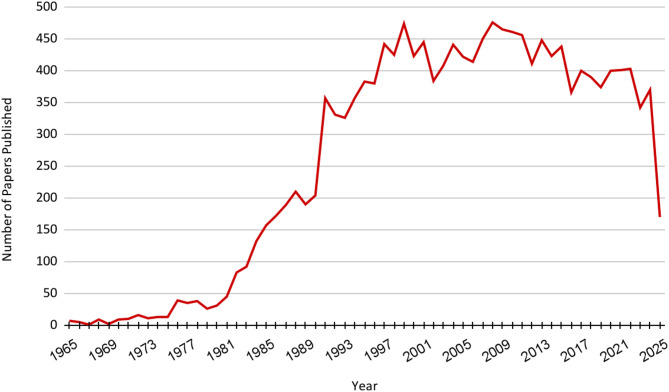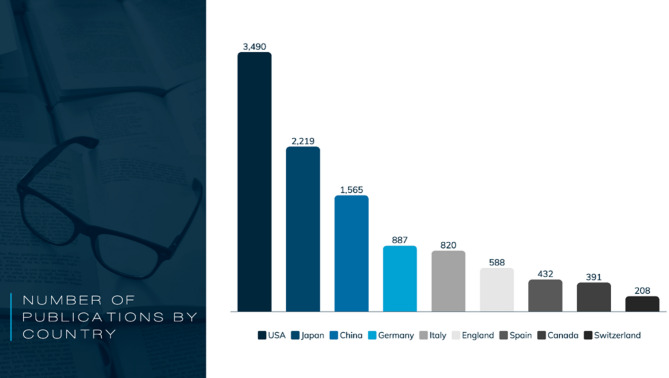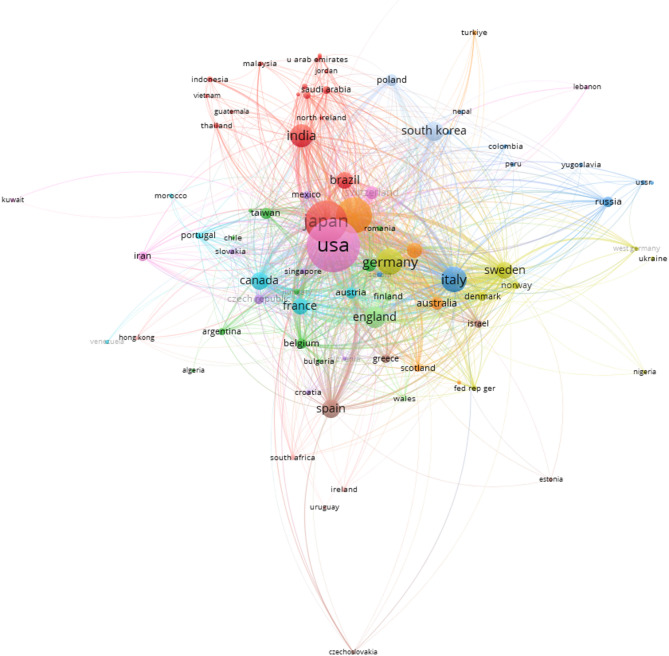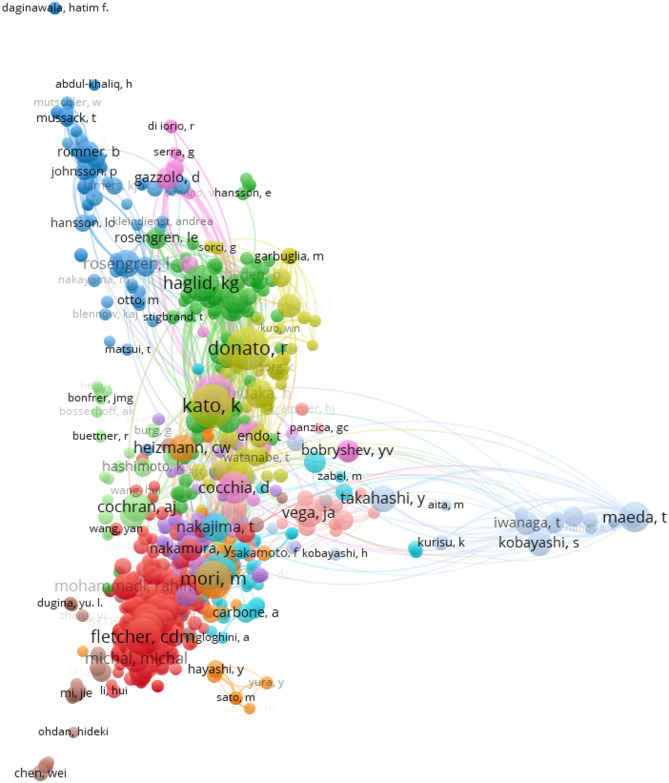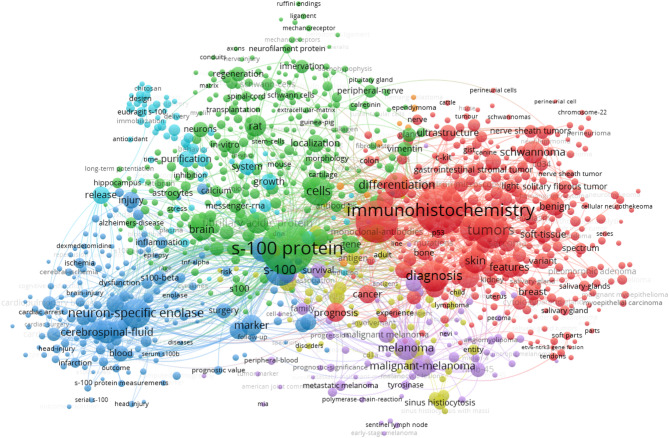Abstract
A bibliometric analysis was performed on academic research from 1965 to 2025 with a focus on S-100B protein and acute ischemic stroke (AIS). In total 15,792 academic papers about S-100B protein and AIS were reviewed, showing a sharp incline in publications after 1980. Leading the publications of research and citations were the United States, followed by Japan and Germany, which also had the highest clustered connections as well. The most prevalent organization was the Harvard University. This bibliometric analysis aims to analyze the prognostic value of S-100B protein as a potential biomarker in AIS with global data.
Keywords: Acute ischemic stroke, S-100B, Biomarkers, Bibliometric analysis
Introduction
Acute ischemic stroke (AIS) represents the ultimate medical emergency, characterized by the rapid onset of focal neurological deficits resulting from the interruption of cerebral blood flow. Stroke occurs when an embolus or thrombus obstructs a cerebral artery, leading to ischemia and subsequent neuronal injury [1]. It is a leading cause of morbidity and mortality worldwide, with an estimated 15 million people affected annually [2].
Biomarkers for ischemic stroke have garnered significant attention in recent years due to their potential to improve early diagnosis, guide therapeutic decision-making, and predict clinical outcomes. Timely and accurate diagnosis is essential for effective treatment, particularly in the context of acute interventions, such as thrombolysis and thrombectomy [3]. S-100B is a calcium-binding protein found in astrocytes in the nervous system and is released to promote neurite growth and regulate cellular processes [4, 5]. When brain cells are damaged during an acute ischemic event, S-100B can leak into the blood or cerebrospinal fluid, marking it as a highly effective potential biomarker [6, 7]. This suggests that its presence may reliably reflect the extent of brain injury and help predict clinical outcomes, making it valuable for prognostication.
Recently, there has been a notable rise in data investigating S-100B’s role as a biomarker for ischemic stroke. In this bibliometric analysis, the authors review the scientific literature on S-100B in ischemic stroke from 1965 to 2025 with the aim to uncover the prognostic significance of the S-100B protein as a serum biomarker in acute ischemic stroke offering insights that may guide and strengthen future research efforts. By mapping current trends and knowledge gaps, the findings of this study can support the development of diagnostic strategies that harness S-100B to improve early detection, risk assessment, and overall diagnostic accuracy in ischemic stroke care.
Methods
Bibliometric methods were used to examine the research landscape of S-100B and its association with acute ischemic stroke using the Web of Science (WOS) as the database and VOSviewer as the visualization software [8]. This approach allows for the systematic and quantitative evaluation of scholarly articles, offering insights into the trends, authors, institutions, and topics within this field.
Data collection
Data were retrieved from the Web of Science Core Collection (WOS), a comprehensive bibliographic database known for its reliable and diverse collection of peer-reviewed literature. The search focused on publications indexed between 1965 and 2025 to capture the most relevant and recent research trends.
The search terms employed were “S-100” (Topic) or “S-100” (Title) and “acute ischemic stroke” (Topic). The inclusion of both “Topic” and “Title” fields for S-100 ensured that the search captured all relevant studies, whether S-100B was the main focus of the article or mentioned in the context of ischemic stroke. The data were then filtered for English-language publications.
Data analysis
The VOSviewer software was used to visualize the bibliometric analysis of the collected data. VOSviewer is a powerful tool for visualizing and analyzing bibliometric networks based on citation, co-citation, bibliographic coupling, and co-authorship data [9]. It allows for the creation of maps that represent the structure of scientific research in an intuitive and interactive format.
After downloading the bibliographic data from WOS, the records were imported into VOSviewer for further analysis. The first step involved generating a co-occurrence network of keywords to identify the most common research themes associated with S-100B and ischemic stroke. VOSviewer uses a threshold to group and visualize frequent terms or keywords that appear in the literature, allowing for a clear representation of the prevailing topics and subtopics in the field.
Citation analysis
To evaluate the influence and impact of the most significant works, citation analysis was performed. Citation counts were used to rank the most influential studies, helping to identify landmark publications in the field of S-100B and ischemic stroke.
The citation data from WOS were then analyzed to generate a citation network, which provides insights into the relationships between frequently cited publications. This step also enabled the identification of research clusters or networks formed around key authors or topics. Next, author and institutional analysis was employed to assess the contributions of individual researchers and institutions to the literature on S-100B and ischemic stroke. A co-authorship network was constructed to identify key researchers and their collaborations. Then, institutional affiliations were mapped to reveal which institutions were leading in this area of research, highlighting the most productive research centers in this topic.
Statistical analysis
Basic descriptive statistics, including the number of publications per year, citation counts, and publication trends, are reported. Trends in publication frequency over time were plotted to identify periods of increased research activity, helping to correlate this with key events in the advancement of ischemic stroke biomarker research.
Results
A total of 15,792 records were retrieved, including 13,696 original research articles, 924 review articles, and 771 conference proceedings, forming the dataset for further network and trend analysis.
Countries and growth
Figure 1 presents a line graph depicting the number of articles published from 1965 to 2025. During the initial period (1965–1980), the growth in publication volume was minimal, with the number of research papers remaining relatively stable. However, beginning in 1981, the graph shows a marked increase in the publication rate, likely reflecting growing technological advancements and heightened research interest that expanded the scope of ischemic stroke studies [10].
Fig. 1.
Publications on S-100B and AIS from 1965–2025. Note the apparent “decline” in 2025 is because of only half a year of publications represented
Researchers from 83 countries published a total of 15,792 papers, with the United States being the leading contributor. The other top nine countries include Japan, Germany, Italy, Sweden, England, China, Canada, Spain, and Switzerland (Fig. 2). The earliest publication in this dataset dates back to 1965, according to Web of Science. Between 1965 and 1980, the average number of papers published per year was 21.6. However, this number rose sharply between 1981 and 2025, with an average of 398.7 papers published annually. This significant increase likely reflects major breakthroughs in stroke research and treatment, including biomarker research [10].
Fig. 2.
Top 10 countries producing publications on S-100B and AIS
Figure 3 shows that the USA leads in the number of publications on S‑100B and AIS, with 3,490 documents and 147,086 citations. The USA has an incredibly strong link strength, demonstrating how prevalent it is in this field of research globally. Japan and Germany are the next most prominent publishers with 2,219 and 887 publications respectively. This indicates that these countries play a significant role in advancing research in this field. However, it is evident that the United States contributes to the majority of publications by a large margin.
Fig. 3.
Countries producing documents and citations on S-100B and AIS
Organizations and authors
Figure 4 demonstrates the organization producing documents and citations on S-100B and acute ischemic stroke.
Fig. 4.
Organizations producing documents and citations on S-100B and AIS
Harvard University, among 960 organizations, holds the largest number of publications, with 150 documents and 7,893 citations. As shown in Fig. 5, Harvard’s extensive network of connections highlights its broad influence and frequent referencing. Other highly productive institutions, such as Università Cattolica del Sacro Cuore (65 documents, 2,424 citations) and University of Texas (135 documents, 13,904 citations), also exhibit strong collaborative ties with Harvard, while maintaining substantial independent outreach and tightly clustered research networks. The findings shown indicate a high level of collaborative research activity, cross-citation, and academic influence among these institutions.
Fig. 5.
Authors producing documents and citations on S-100B and AIS
Fabrizio Michetti of the Università Cattolica del Sacro Cuore is the most prominent author in the field of S-100B biomarker research, with a notable record of 66 publications and 3,092 citations. R. Donato and D. Cocchia have also published extensively on the topic. These three scholars have not only produced a comparable volume of research but have frequently collaborated with one another and cited each other’s work [11]. Their interconnected contributions are visually represented in the accompanying network graph, underscoring the depth of their academic partnership and influence in the field.
Keywords
Out of a set of 1,000 keywords, the term “S-100 protein” appeared most frequently, with 1,805 occurrences. This was followed by “immunohistochemistry” (1,569), “expression” (1,155), “tumors” (831), and “neuron-specific enolase” (531). Figure 6 illustrates these findings, showing clusters centered around “S-100 protein” and “immunohistochemistry,” which are linked to numerous other keywords with strong link strength.
Fig. 6.
Prominent keywords used in database
Discussion
This bibliometric analysis of 15,792 academic papers from 83 countries provides a detailed landscape for data analysis on the prognostic value of S-100B in acute ischemic stroke. In these findings, the United States is marked as a trailblazer in research and influence, and the other prominent countries in terms of research influence with Japan and Germany also contributing significantly to scientific advancement. The rise of research after 1980 aligns with discoveries in S-100B protein and acute ischemic stroke. For example, the rise of tissue plasminogen activator as an acute therapy for acute ischemic stroke increased the quantity of research done on acute ischemic stroke [12]. At the same time, S-100B protein being found as a sign of cell damage also increased and supported the rise of research done as a biomarker [10].
Institutional collaboration and research
Harvard University had the highest number of publications in AIS and S-100B. Acting as a node for publications, it also has strong ties with the Università Cattolica del Sacro Cuore and the University of Texas, both of which are globally prevalent in research regarding this topic. The collaboration and cross-citation of these universities is robust [11].
Authors and contributions
The individual contributions of prominent researchers, like Professor Michetti, Donato, and Cocchia, play an important role in understanding the patterns and how experts play a role in shaping research in a field [12, 13]. Professor Michetti’s research in S-100B as a biomarker in various different fields, including neuroscience and diabetes, has continued to showcase S-100B’s novelty [14, 15]. In collaboration with Donato and/or Cocchia, he explored the protein’s use in intracellular and immunochemical processes, which are essential in connecting the topic to stroke.
Strengths and limitations
While the use of Web of Science and VOSviewer for bibliometric analysis offers a robust methodology for examining trends, citation patterns, and author contributions, several limitations must be acknowledged. First, the reliance on Web of Science as the sole database for data collection may introduce selection bias, as it does not encompass all published literature. Articles indexed in other major databases, such as PubMed, Scopus, or Embase, may be excluded, potentially overlooking relevant studies, particularly those from journals not covered by Web of Science. Furthermore, the keyword-based search strategy, while efficient, may not capture all pertinent research, particularly studies in which S-100B is indirectly related to ischemic stroke or mentioned in passing within broader contexts. Additionally, VOSviewer, though a powerful tool for visualizing bibliometric networks, may limit nuanced interpretation by focusing primarily on citation and co-authorship patterns, without fully accounting for the quality or clinical relevance of the studies. Finally, the bibliometric methods employed do not assess the methodological rigor or scientific impact of individual studies, which may be critical for drawing comprehensive conclusions about the clinical significance of S-100B in ischemic stroke. Therefore, while these tools provide valuable insights, they should be supplemented by a more holistic review of the literature to ensure a comprehensive understanding of the research landscape.
Conclusion
In this bibliometric analysis of S-100B and ischemic stroke from 1965 to 2025, the USA, Japan, and Germany were the most productive countries with regard to research output and cross-citations, respectively. With an impressive range of collaboration and research output, Harvard University emerged as the most influential organization with research in S-100B and AIS. The three most collaborative and published authors in this field were Professor Michetti, Donato, and Cocchia. The broad topic of S-100B and AIS produced prominent keywords such as “S-100 protein”, “immunohistochemistry”, and “expression”. This bibliometric analysis provides a global visualization of the research landscape on S-100B in acute ischemic stroke.
Authors’ contributions
SG and SM drafted the initial manuscript. LG edited and critically revised the manuscript. All authors read and approved the final manuscript.
Funding
No funding was received for this study.
Data availability
No datasets were generated or analysed during the current study.
Declarations
Ethics approval and consent to participate
The study was performed in accordance with the ethical standards as laid down in the 1964 Declaration of Helsinki and its later amendments or comparable ethical standards.
Consent for publication
Not applicable.
Competing interests
Dr. Ganti has an editorial role at Springer.
Footnotes
Publisher’s Note
Springer Nature remains neutral with regard to jurisdictional claims in published maps and institutional affiliations.
References
- 1.Ganti L. Management of acute ischemic stroke in the emergency department: optimizing the brain. Int J Emerg Med. 2025;18(1):7. Published 2025 Jan 7. 10.1186/s12245-024-00780-5. Yew KS, Cheng EM. Diagnosis of acute stroke. Am Fam Physician. 2015;91(8):528–536.
- 2.Feigin VL, Brainin M, Norrving B, et al. World stroke organization: global stroke fact sheet 2025. Int J Stroke. 2025;20(2):132–44. 10.1177/17474930241308142. [DOI] [PMC free article] [PubMed] [Google Scholar]
- 3.Babić A, Bonifačić D, Komen V, Kovačić S, Mamić M, Vuletić V. Blood biomarkers in ischemic stroke diagnostics and Treatment-Future perspectives. Med (Kaunas). 2025;61(3):514. 10.3390/medicina61030514. Published 17 Mar 2025. [DOI] [PMC free article] [PubMed] [Google Scholar]
- 4.Qu Y, Jin H, Abuduxukuer R, Qi S, Si XK, Zhang P, Zhang KJ, Wang SJ, Zheng XY, Zhang Y, Gao JH, Zhang XK, Liu XD, Li CY, Li GC, Wang J, Jin H, He Y, Jiang L, Liu L, Jiang Y, Teng RH, Jia Y, Zhang BJ, Chen Z, Qi Y, Liu X, Li S, Sun X, Nguyen TN, Yang Y, Guo ZN. The association between serum S100β levels and prognosis in acute stroke patients after intravenous thrombolysis: a multicenter prospective cohort study. BMC Med. 2024;22(1):304. 10.1186/s12916-024-03517-6. PMID: 39358745; PMCID: PMC11447957. Biomarkers of Brain Injury Investigator Study Group. [DOI] [PMC free article] [PubMed] [Google Scholar]
- 5.Michetti F, Clementi ME, Di Liddo R, Valeriani F, Ria F, Rende M, Di Sante G, Romano Spica V. The S100B protein: A multifaceted pathogenic factor more than a biomarker. Int J Mol Sci. 2023;24(11):9605. 10.3390/ijms24119605. PMID: 37298554; PMCID: PMC10253509. [DOI] [PMC free article] [PubMed] [Google Scholar]
- 6.Gayger-Dias V, Vizuete AF, Rodrigues L, Wartchow KM, Bobermin L, Leite MC, Quincozes-Santos A, Kleindienst A, Gonçalves CA. How S100B crosses brain barriers and why it is considered a peripheral marker of brain injury. Exp Biol Med (Maywood). 2023;248(22):2109–19. Epub 2023 Dec 6. PMID: 38058025; PMCID: PMC10800124. [DOI] [PMC free article] [PubMed] [Google Scholar]
- 7.Nash DL, Bellolio MF, Stead LG. S100 as a marker of acute brain ischemia: a systematic review. Neurocrit Care. 2008;8(2):301-7. 10.1007/s12028-007-9019-x. PMID: 17968519. [DOI] [PubMed]
- 8.Ganti L, Persaud NA, Stead TS. Bibliometric analysis methods for the medical literature. Academic Medicine & Surgery. Published online Jan 30, 2025. 10.62186/001c.129134
- 9.McAllister JT, Lennertz L, Atencio Mojica Z. Mapping A discipline: A guide to using VOSviewer for bibliometric and visual analysis. Sci Technol Libr. 2021;41(3):319–48. 10.1080/0194262X.2021.1991547. [Google Scholar]
- 10.Persson L, Hårdemark HG, Gustafsson J, et al. S-100 protein and neuron-specific enolase in cerebrospinal fluid and serum: markers of cell damage in human central nervous system. Stroke. 1987;18(5):911–8. 10.1161/01.str.18.5.911. [DOI] [PubMed] [Google Scholar]
- 11.Honegger T, Schweizer J, Bicvic A, Westphal LP, Schütz V, Inauen C, Pokorny T, Bracher K, Arnold M, Fischer U, Bonati LH, De Marchis GM, Nedeltchev K, Kahles T, Cereda C, Kägi G, Montaner J, Bustamante A, Palà E, Ntaios G, Foerch C, Luft A, Spanaus K, Saleh L, von Eckardstein A, Arnold M, Katan M. Serum S-100B adds incremental value for the prediction of symptomatic intracranial hemorrhage and brain edema after acute ischemic stroke. Eur Stroke J. 2023;8(1):309–19. Epub 2022 Dec 21. PMID: 37021149; PMCID: PMC10068408. [DOI] [PMC free article] [PubMed] [Google Scholar]
- 12.Cocchia D, Michetti F, Donato R. Immunochemical and immuno-cytochemical localization of S-100 antigen in normal human skin. Nature. 1981;294(5836):85 – 7. 10.1038/294085a0. PMID: 7290214. [DOI] [PubMed]
- 13.Cocchia D, Pansera F, Palumbo A, Donato R. Immunocytochemical localization of S-100 protein binding sites in synaptosomal fractions and subfractions. Cell Mol Neurobiol. 1982;2(4):265–76. PMID: 7183417; PMCID: PMC11572891. [DOI] [PMC free article] [PubMed] [Google Scholar]
- 14.Michetti F, Di Sante G, Clementi ME, Valeriani F, Mandarano M, Ria F, Di Liddo R, Rende M. Romano spica V. The multifaceted S100B protein: A role in obesity and diabetes? Int J Mol Sci. 2024;25(2):776. 10.3390/ijms25020776. PMID: 38255850; PMCID: PMC10815019. [DOI] [PMC free article] [PubMed] [Google Scholar]
- 15.Michetti F, D’Ambrosi N, Toesca A, Puglisi MA, Serrano A, Marchese E, Corvino V, Geloso MC. The S100B story: from biomarker to active factor in neural injury. J Neurochem. 2019;148(2):168–87. 10.1111/jnc.14574. Epub 2018 Nov 12. PMID: 30144068. [DOI] [PubMed] [Google Scholar]
Associated Data
This section collects any data citations, data availability statements, or supplementary materials included in this article.
Data Availability Statement
No datasets were generated or analysed during the current study.



